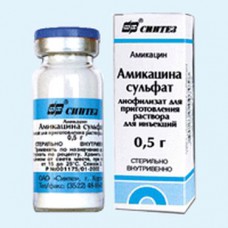Expiration date: 07/2026
Structure and Composition:
1 vial of lyophilized powder for solution for injection for in / in / m introduction includes amikacin sulfate 250 mg or 500 mg in bottles of 10 ml in a cardboard unit 1 or 10 vials and 50 vials per box.
Characteristic:
Powder or porous mass of white or white with a yellowish tint, hygroscopic.
Pharmacokinetics:
When i / m administration is rapidly absorbed, Cmax achieved within 1 hour. The on / in a drip concentration in blood is greater than observed when the / m introduction. Dynamics of reduction of blood at / in the drip is similar to that when i / m administration, therapeutic concentrations with the / m and in / in drip saved up to 10-12 hours. The antibiotic is detected in lung tissue, liver, myocardium, spleen , bone, pleural and peritoneal exudates, synovial fluid, bronchial secretions, bile. Selectively accumulates in the cortical layer of the kidney. It penetrates through the BBB and is found in the cerebrospinal fluid. When inflammation of meningeal membranes penetration into the cerebrospinal fluid increases. It crosses the placenta and is found in fetal blood and amniotic fluid. It is displayed in an active form by the kidneys by glomerular filtration rate, a high concentration in urine. Patients with impaired renal function increases the concentration of drug in the blood and significantly increases the circulation time in the body.
Description of the pharmacological actions:
It is active against gram-positive and gram-negative microorganisms: Staphylococcus, including penitsillino- and methicillin-resistant strains, Escherichia coli, Proteus spp, Providencia, Serratia group of microorganisms, Klebsiella, Enterobacter, Citrobacter, Salmonella, Shigella, Pseudomonas aeruginosa, including. gentamitsino-, tobramitsino- and sizomitsinoustoychivye strains. Moderately active against streptococci, enterococci, pneumococci. Not active against Gram-negative anaerobes asporogenous and protozoa.
Indications:
Severe infections caused by susceptible to malaria infections: sepsis, meningitis, peritonitis, septic endocarditis, infectious and inflammatory diseases of the respiratory system (pneumonia, empyema, lung abscess), infections of the kidneys and urinary tract, especially the complicated and often recurrent (pyelonephritis, urethritis, cystitis ) infected burns, etc.
Contraindications:
Hypersensitivity, cochlear neuritis, disorders of the vestibular apparatus, azotemia (residual nitrogen is higher than 150 mg%), myasthenia gravis, pregnancy.
Application of pregnancy and breastfeeding:
When pregnancy is used only for health reasons.
Side effect:
From the nervous system and sensory organs: headache, ototoxic effects (hearing loss - reducing the perception of high tones, vestibular disorders - dizziness) is very rare - a blockade of neuromuscular conduction.
With the genitourinary system: nephrotoxicity (increased residual nitrogen of blood serum, a decrease in creatinine clearance, oliguria, proteinuria, cylindruria) - usually reversible.
Allergic reactions: skin rash, fever, and others.
Other: phlebitis and periflebit (with on / in the introduction).
Drug Interactions:
Streptomycin, kanamycin, monomitsin, gentamicin, tobramycin, viomycin, polymyxin B, and diuretics (furosemide, ethacrynic acid) increase the risk of dis- / nephrotoxicity (can not be administered simultaneously or sequentially). Pharmaceutical incompatible with others. PM (can not be administered in the same syringe).
Dosage and administration:
V / m or / in (drip). Adolescents and adults with normal renal function - 15 mg / kg / day (5 mg / kg every 8 hours or 7.5 mg / kg every 12 h), children initial single dose - 10 mg / kg in the future - for 7.5 mg / kg every 12 hours maximum daily dose -. 1.5 g total course dose - no more than 15, with the absence of effect for 5 days are switching to treatment with other drugs. Duration of treatment - 7-10 days.
Patients with kidney failure to reduce the dose or increase the interval between doses without changing a single dose. The interval is calculated by the formula: concentration of creatinine in serum x 9. The first dose in patients with renal failure is 7.5 mg / kg for subsequent doses calculation using the formula: Cl creatinine (ml / min) x Initial Dose (mg) / Cl creatinine OK (ml / min).
Precautionary measures:
In patients with hypersensitivity to others. Aminoglycosides may develop cross-allergic reaction to amikacin. When allergic reactions, drug overturned and prescribe diphenhydramine, calcium chloride, and others. It is recommended to use the drug under the control of kidney function, hearing and vestibular apparatus (at least 1 time per week) In order to prevent complications. The incidence of vestibular and hearing disorders is increased in patients with renal insufficiency. The likelihood of Oto-and nephrotoxicity increases with prolonged use and high doses. At the first sign of the blockade of neuromuscular conduction should be discontinued immediately and administration of the drug to enter the I / calcium chloride or p / neostigmine and atropine solution is a solution, if necessary, the patient is transferred to controlled breathing.
Special instructions:
Before using the product it is necessary to determine the sensitivity of microorganisms to antibiotics (used disks containing 30 micrograms amikacin sulfate). When the diameter of the zones of 17 mm or more - the microorganism is considered sensitive, 15-16 mm - moderately sensitive, at least 14 mm - stable. During treatment should control the content of the antibiotic in plasma (concentration should not exceed 30 mg / ml).
For the / m, a solution prepared ex tempore of a lyophilized powder, the contents of the vial (250 mg or 500 mg of powder) 3.2 ml of water for injection. For on / in the diluted into 200 ml of 5% glucose solution or 0.9% sodium chloride solution. The concentration of amikacin in the solution for the on / in the introduction should not exceed 5 mg / ml.


